Transparency Begins with Data Management

Meeting the demands of new product regulations requires better data management solutions. We sat down this week with 3E Company's Connie Prostko-Bell to learn more about this emerging issue and to find out what companies are doing to provide greater supply chain transparency.
GT: Why do companies collect MSDSs and other product data from their suppliers? What is this information used for?
CPB: Operational risk and compliance management is increasingly focused on environmental issues across the supply chain. As companies strive to deliver sustainable ongoing improvements in compliance and risk management, they are closely scrutinizing the management of products in the enterprise, especially chemicals and other hazardous materials, with a special emphasis on fulfilling requirements in environmental, health and safety (EHS) regulatory compliance. A comprehensive view of compliance performance and risk management throughout the supply chain and product life cycle is necessary to promote and sustain ongoing improvement.
This vision is fueled by accurate and comprehensive content, including environmental, health and safety (EHS) product data, such as Material Safety Data Sheets (MSDS), which can be leveraged to ensure that the products that are incorporated into finished goods meet legal, regulatory, industry and self-imposed standards. Leveraging this type of data helps communicate to a company’s stakeholders that externally sourced processes and materials do not introduce legal, financial, ethical or market access risks to the company. Furthermore, it gives organizations an opportunity to advance their own value-based agendas by leveraging buying power to enforce desired practices.
GT: What trends are driving the management of supplier-sourced product data?
CPB: Manufacturers with complex supply chains are struggling under the burden of spiraling global EHS regulations. More often than not, they possess neither the requisite internal methodologies nor the necessary personnel to collect, analyze, share, and distribute key information related to supplier compliance and corporate risk across the various functional groups within the organization. Compliance issues such as GHS, REACh, RoHS and Frank-Dodd are driving the need for a common source of product data.
The shifting regulatory landscape also burdens suppliers, who often need help gaining access from suppliers and understanding the global EHS laws with which they must comply. Companies are increasingly recognizing supplier compliance as a critical component of business continuity efforts.
GT: A company’s efforts are only as strong as the quality of its data. How can companies ensure data quality, especially when they are dealing with a multitude of suppliers?
CPB: The number of suppliers can vary wildly from company to company. Generally speaking, it is safe to say that the larger the organization, the more suppliers it will have. Many factors influence this number such as geographical diversity of operations and customers, the complexity of the product line, and availability of the required raw materials. It is certainly not uncommon for a large company to have tens of thousands of suppliers. However, regardless of whether the company has hundreds or thousands of suppliers, managing supplier data can be a very challenging task. Finding, maintaining and acting on data is difficult and painstakingly time-consuming.
It is important that companies use documented, best practice methodologies and direct relationships to gather, refine and maintain data.
When it comes to sharing the information, you should choose an easy-to-use and practical system that meet each customer's specific needs. The data should be broad, dynamically updated, and of the highest quality and accuracy. Substance- level regulatory data and product level MSDS data should be integrated together to provide a view into the impact of regulatory changes across inventories in the enterprise.
At the product level, from its inception to the present day, the vendor supplied product MSDS has evolved into a document that goes far beyond its original purpose, now serving as a source, foundation and clearinghouse for a range of safety and regulatory compliance data, including classification, transportation, environmental, ecological and disposal considerations. MSDS product-level data should be continuously updated with information and search technologies, documented best practice methodologies and through direct data obtainment relationships with raw material and other chemical product manufacturers.
Connie Prostko-Bell is a Senior Solutions Manager with 3E Company. She has 16 years of EH&S and chemical industry experience, spanning the project management, product safety and product stewardship sectors. She will share strategies for getting accurate supplier data during NAEM's webinar on the topic Feb. 16.
Related
About the Author

NAEM Staff
The National Association for Environmental, Health and Safety, and Sustainability (EHS&S) Management (NAEM) empowers corporate leaders to advance environmental stewardship, create safe and healthy workplaces and promote global sustainability. As the
leading business community for EHS&S decision-makers, we provide engaging forums, a curated network, peer benchmarking, research insights and tools for solving today’s corporate EHS&S management challenges. Visit us online at naem.org.

